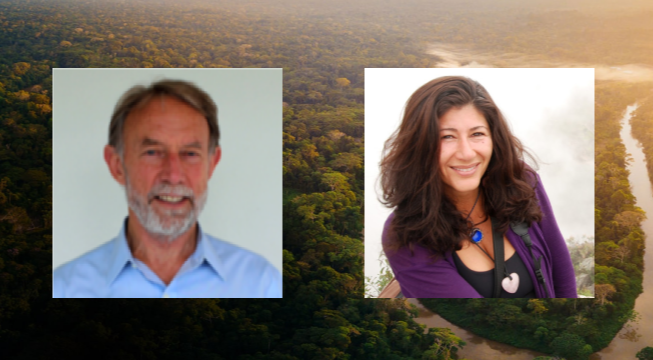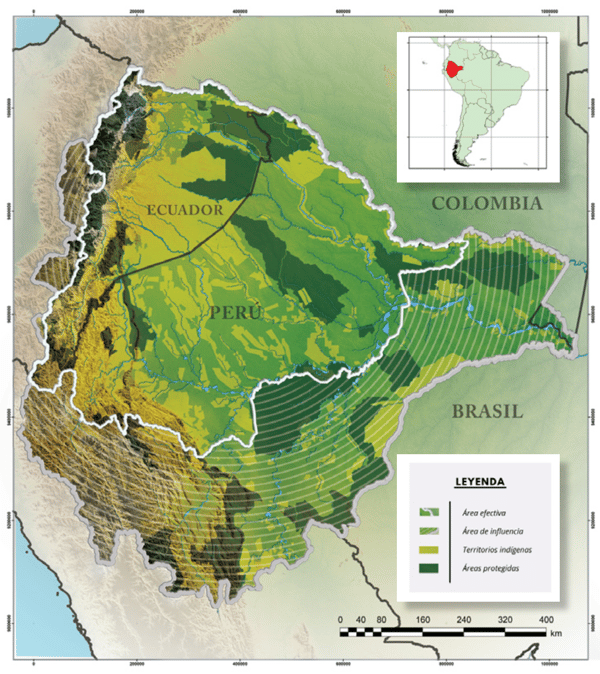Work in the Amazon: A Conversation with Atossa Soltani and Bill Twist
 The following conversation was part of the Resilience and Possibility series. To access the recording, please scroll to the bottom of this post.
The following conversation was part of the Resilience and Possibility series. To access the recording, please scroll to the bottom of this post.
On July 19, the global Pachamama Alliance community came together with Atossa Soltani and Bill Twist for a conversation on the Amazon Sacred Headwaters Initiative. This Indigenous-led initiative aims to permanently protect the Sacred Headwaters region—which spans over 86 million acres of the Amazon rainforest—through local Indigenous leadership and management.
Atossa is the Founder of Amazon Watch where she served as the Executive Director for 18 years. Amazon Watch was founded in 1996 to protect the rainforest and advance the rights of Indigenous peoples of the Amazon Basin. Currently, Atossa is the Board President at Amazon Watch and the Director of Global Strategy for the Amazon Sacred Headwaters Initiative.
Bill is one of the Co-founders and current President of Pachamama Alliance, and has been working alongside the Indigenous peoples of the Amazon rainforest in Ecuador to protect their territories for many years.
Forming a Powerful Alliance
The Amazon Sacred Headwaters region is where the headwaters of the Amazon River starts, with over 30 different Indigenous nations residing in this area.

The Amazon Sacred Headwaters region, outlined in white, is one of the most biodiverse areas of the rainforest.
In 2017, these Indigenous nations came together and started organizing to defend their territories against extractive industries with support from their allies, including non-governmental organizations like Pachamama Alliance and Amazon Watch.
As Bill explained, before the Initiative, the Indigenous peoples of this region were focused primarily on defending their territories against oil drilling, mining, and deforestation. However, they decided to shift their approach. Instead of just defending their lands against ongoing threats, they wanted to develop a powerful vision for the future where their communities and the Amazon could thrive under their collective stewardship.
The result was the Amazon Sacred Headwaters Initiative, which includes the Indigenous peoples’ plan for the long-term protection of this area. This plan, called the Bioregional Plan, aims to bring forth a different reality where the wellbeing of Indigenous peoples and the forest are at the center of government decisions.
Two of the primary goals is to protect at least 80% of the Amazon by 2025 and to permanently protect and restore the Sacred Headwaters region by 2030. This will ensure a thriving future not just for the Indigenous communities in this region, but also for all life on Earth given the critical role the Amazon plays in the wellbeing of the entire planet.
The Critical Role of the Amazon and Indigenous Stewardship
As Atossa pointed out, the Amazon is not only the "lungs of the Earth" given its absorption of carbon dioxide and oxygen release, but it also plays a crucial role as the heart of the planet's hydro-climatic system. The forest generates atmospheric rivers that provide a significant portion of the rain in South America and even impacts the distribution of water in North America. As Atossa put it, “We are one planet with one circulatory system of water—of which the Amazon is the heart pump.”
However, the Amazon is facing rapid deforestation, losing about 10,000 acres of forest cover each day.
Oil drilling, mining, logging, roads, dams, and industrial infrastructure are polluting the Amazon and driving deforestation. Atossa made it clear that the Amazon has already reached a tipping point where a massive dieback of the rainforest could occur within the next hundred years if urgent action is not taken.
Atossa stressed the importance of advancing Indigenous governance and territorial rights for Indigenous peoples to maintain their self-determination and protect their lands effectively. She emphasized the critical role of Indigenous peoples as stewards of the forest, explaining that their territories are the most biodiverse and experience the lowest rates of deforestation.
As Gregorio Mirabal—Chief Coordinator of COICA, an organization that brings together all of the Indigenous nations and organizations of the Amazon—powerfully put it, “Our relationship with our forests and rivers is not a relationship of 10 or 20 years, it's a relationship of more than 10,000 years. For thousands of years, we have preserved and defended nature through the strength of our culture's worldview and our way of respecting nature."
Current Projects of the Amazon Sacred Headwaters Initiative
Currently, the Amazon Sacred Headwaters Initiative is implementing each of the Indigenous nations’ holistic plans for the wellbeing of their territories and communities.
The Achuar, for instance, are developing projects to protect their lands, advance their sovereignty, address food insecurity through traditional agroforestry, provide culturally appropriate education, and preserve their culture and traditional knowledge.
The Achuar are also working with Fundación Pachamama, Pachamama Alliance’s sister organization in Ecuador, to develop economic alternatives to extractivism for their communities. This includes the sustainable cultivation and harvesting of resources from the Amazon so that local communities can generate income for necessities such as their children’s education or medical emergencies.
To implement these projects, the Amazon Sacred Headwaters Initiative has started the Living Amazon School so that young people from these communities can cultivate the skills they need to manage the projects. Through the Living Amazon School, elders pass down their traditional knowledge to the youth who are also learning other key skills like how to use satellite technology to monitor their territories, advancing land rights, forest management, and governance.
In addition to strengthening economic security at the local level, the Initiative is also pushing for systemic solutions. These include universal basic income, universal basic services, and debt relief.
As Atossa explained, countries like Ecuador that include the Amazon within its borders are on average spending 70% of their national GDP to service external debt owed to foreign lenders. As she put it, much of the money generated from oil drilling and mining in these countries goes towards mortgaging or paying the interest for these debts. Atossa pointed to the financial mechanisms of the global economic system as being at fault for this. One of the solutions is for the global economic system to create financial incentives to protect the Amazon, such as by tying debt relief to governments' conservation efforts.
How to Support the Amazon Sacred Headwaters Initiative
To support the Initiative, Atossa encouraged people to sign the declaration on the Sacred Headwaters website in support of the Indigenous peoples working to protect the Amazon. She also recommended offering financial or technical assistance to bring greater visibility to this critical work and provide support to the many projects emerging from the Initiative.
In addition to directly supporting the Initiative, Atossa highlighted the importance of staying attuned to international events where world leaders and Indigenous people from the Amazon are coming together around the future of the rainforest.
She spoke about the upcoming summit in Belém, Brazil where the presidents of all nine countries that include the Amazon within their borders will negotiate a global agreement to avert the tipping point of no return in the Amazon. In the weeks leading up to this summit, Indigenous people from the Amazon have been voicing their demands. One of their demands is for the governments of all nine countries to demarcate the hundred million hectares of the rainforest that's claimed by Indigenous peoples by 2025.
“Everyone should be listening and tuning in,” said Atossa. “It's the fate of the world at stake."